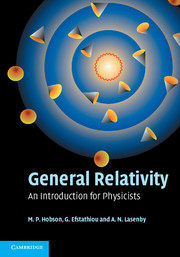Book contents
- Frontmatter
- Contents
- Preface
- 1 The spacetime of special relativity
- 2 Manifolds and coordinates
- 3 Vector calculus on manifolds
- 4 Tensor calculus on manifolds
- 5 Special relativity revisited
- 6 Electromagnetism
- 7 The equivalence principle and spacetime curvature
- 8 The gravitational field equations
- 9 The Schwarzschild geometry
- 10 Experimental tests of general relativity
- 11 Schwarzschild black holes
- 12 Further spherically symmetric geometries
- 13 The Kerr geometry
- 14 The Friedmann–Robertson–Walker geometry
- 15 Cosmological models
- 16 Inflationary cosmology
- 17 Linearised general relativity
- 18 Gravitational waves
- 19 A variational approach to general relativity
- Bibliography
- Index
13 - The Kerr geometry
Published online by Cambridge University Press: 05 September 2012
- Frontmatter
- Contents
- Preface
- 1 The spacetime of special relativity
- 2 Manifolds and coordinates
- 3 Vector calculus on manifolds
- 4 Tensor calculus on manifolds
- 5 Special relativity revisited
- 6 Electromagnetism
- 7 The equivalence principle and spacetime curvature
- 8 The gravitational field equations
- 9 The Schwarzschild geometry
- 10 Experimental tests of general relativity
- 11 Schwarzschild black holes
- 12 Further spherically symmetric geometries
- 13 The Kerr geometry
- 14 The Friedmann–Robertson–Walker geometry
- 15 Cosmological models
- 16 Inflationary cosmology
- 17 Linearised general relativity
- 18 Gravitational waves
- 19 A variational approach to general relativity
- Bibliography
- Index
Summary
The Schwarzschild solution describes the spacetime geometry outside a spherically symmetric massive object, characterised only by its mass M. In the previous chapter we derived further spherically symmetric solutions. Most real astrophysical objects, however, are rotating. In this case, a spherically symmetric solution cannot apply because the rotation axis of the object defines a special direction, so destroying the isotropy of the solution. For this reason, in general relativity it is not possible to find a coordinate system that reduces the spacetime geometry outside a rotating (uncharged) body to the Schwarzschild geometry. The non-linear field equations couple the source to the exterior geometry. Moreover, a rotating body is characterised not only by its mass M but also by its angular momentum J, and so we would expect the corresponding spacetime metric to depend upon these two parameters.
We now consider how to derive the metric describing the spacetime geometry outside a rotating body. Since the mathematical complexity in this case is far greater than that encountered in deriving the Schwarzschild metric (or the other spherically symmetric geometries discussed in the previous chapter), we shall content ourselves with just an outline of how the solution may be obtained.
The general stationary axisymmetric metric
In our derivation of the Schwarzschild solution, we began by constructing the general form of the static isotropic metric. We are now interested in deriving the spacetime geometry outside a steadily rotating massive body.
Information
- Type
- Chapter
- Information
- General RelativityAn Introduction for Physicists, pp. 310 - 354Publisher: Cambridge University PressPrint publication year: 2006
